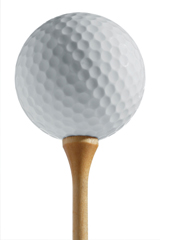It's Easy to Get Cheap Practice Golf Balls
Practice golf balls are always in demand. Every golfer can get better by practicing. Professionals practice several hours a day, and while I'm not suggesting that amateurs should follow that same sort of practice schedule, we could all improve our games by practicing more regularly.
When you want to practice, you can go to a nearby driving range. Most golf courses have their own ranges, but independently-operated driving ranges are also scattered around. Ranges are fine for practicing full shots. You can hit any club you want to on a driving range, from your driver all the way down to your sand wedge or lob wedge. And many driving ranges have short-game practice areas which include a bunker and a putting green.
But what do you do if you want to practice but you're not close to a range? Well, you could look for a place much closer to home where you could just drop some balls and hit them. For example, a wide-open field is across the street from my house. It's the perfect place for me to practice and I don't even need to get into my car. But, because it's not a driving range, I need to bring some practice golf balls with me.
When I want to work on my game, I just grab my clubs and a shag bag of practice golf balls and walk across the street. I hit the balls until the shag bag's empty, and then I walk out and collect them. If I want to hit more, I repeat the process. If not, I walk back home.

I don't always find all the practice golf balls I hit, though. You know how it goes. Balls hide in tall grass or sneak beneath a pile of leaves. So, there are a lot of days when I'll lose at least one or two of my golf practice balls. Being a financially responsible golfer (some people would call me "cheap") who recognizes that my balls will eventually get beat up even if I don't lose them, I don't want to use anything expensive for my golf practice balls.
There are a lot of ways to build up a supply of inexpensive practice balls. First of all, it's pretty common to find someone else's lost ball while you're playing a round. Before I moved to the South, I used to play on a really tight, tree-lined course where people lost balls all the time. Some rounds, I would find ten or twelve of them. In addition to finding balls in the trees and high rough, if you have a ball retriever you can often fish some out of ponds. Most of the balls I find go straight into my shag bag to be used as practice golf balls. Free is good.
You can also buy practice golf balls pretty inexpensively. Look for cheap used golf balls at flea markets, swap meets and yard sales. You can often pick up a dozen for less than $2 or $3, and a lot of them are in pretty nice condition - certainly good enough to be used as practice golf balls.
Some pro shops sell used golf balls that have been found or fished out of ponds. You'll probably pay more at a pro shop than you would at a yard sale or flea market, but these pro shops can still be a good source of golf practice balls.
A number of online shops also sell used golf balls that can be used as golf practice balls. Some websites call them "recycled" balls rather than used golf balls. Most of these online shops grade their used balls (some use a letter system like A, AA, AAA, AAAA and AAAAA, where "AAAAA" is near mint and "A" is pretty beat up; others grade their balls as poor, fair, good, excellent, or near mint - you get the idea). The grading system is useful because you'll always know the quality of the balls you're buying. Naturally, used balls that are in excellent condition will cost more than balls that are not in very good shape, but used balls are always less expensive than if you bought the same brand of ball brand new.
Now that I've given you a few ideas on how to get some practice golf balls inexpensively, go out and hit some as soon as you have the opportunity. Your game will thank you.
From practice golf balls to golf ball reviews.



New! Comments
Have your say about what you just read! Leave us a comment in the box below.